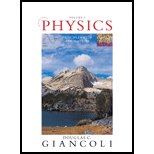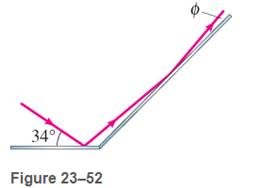
Physics
7th Edition
ISBN: 9780321625915
Author: Douglas C. Giancoli
Publisher: PEARSON
expand_more
expand_more
format_list_bulleted
Concept explainers
Textbook Question
Chapter 23, Problem 3P
Two plane mirrors meet at a 1350 angle, Fig. 23-52. If light rays strike one mirror at 340 as shown, at what angle φ do they leave the second mirror?

Expert Solution & Answer
Want to see the full answer?
Check out a sample textbook solution
Students have asked these similar questions
220 volts is supplied across 1200 winding of the primary coil of the autotransformer.If 1650 windings are tapped, what voltage will be supplied to the primary coil of thehigh-voltage transformer?2. A kVp meter reads 86 kVp and the turns ratio of the high-voltage step-up transformeris 1200. What is the true voltage across the meter?3. The supply voltage from the autotransformer to the filament transformer is 60 volts. If theturns ratio of the filament transformer is 1/12, what is the filament voltage?4. If the current in the primary side of the filament transformer in question 3 were 0.5 A,what would be the filament current?5. The supply to a high-voltage step-up transformer with a turns ratio of 550 is 190 volts.What is the voltage across the x-ray tube?
220 V is supplied to 800 primary turns of an autotransformer. What will the outputvoltage be across 200 secondary turns?
2. A filament transformer has a turns ratio of 1:20. What current must be supplied to theprimary windings if 5 A is required by the filament?
3. The filament transformer in the previous question is supplied with 150 V to theprimary side. What is the secondary voltage?
4. 440 V is supplied to 1000 primary turns of an autotransformer. If the desired outputvoltage is 100 V how many secondary turns must be tapped?
Please solve and answer thw question correctly please. Thank you!!
Chapter 23 Solutions
Physics
Ch. 23 - Prob. 1OQCh. 23 - Prob. 2OQCh. 23 - Prob. 1QCh. 23 - What is the focal length of a plane mirror? What...Ch. 23 - Prob. 3QCh. 23 - Prob. 4QCh. 23 - Prob. 5QCh. 23 - Prob. 6QCh. 23 - Prob. 7QCh. 23 - Prob. 8Q
Ch. 23 - Prob. 9QCh. 23 - Prob. 10QCh. 23 - Prob. 11QCh. 23 - You look into an aquarium and view a fish inside....Ch. 23 - Prob. 13QCh. 23 - Prob. 14QCh. 23 - A child looks into a pool to see how deep it is....Ch. 23 - Prob. 16QCh. 23 - Prob. 17QCh. 23 - Prob. 18QCh. 23 - Prob. 19QCh. 23 - Prob. 20QCh. 23 - Prob. 21QCh. 23 - Prob. 22QCh. 23 - Prob. 23QCh. 23 - Prob. 24QCh. 23 - Prob. 25QCh. 23 - Prob. 26QCh. 23 - Prob. 27QCh. 23 - Prob. 28QCh. 23 - Prob. 29QCh. 23 - Prob. 30QCh. 23 - Prob. 31QCh. 23 - Prob. 32QCh. 23 - Prob. 1MCQCh. 23 - Prob. 2MCQCh. 23 - Prob. 3MCQCh. 23 - Prob. 4MCQCh. 23 - Prob. 5MCQCh. 23 - Prob. 6MCQCh. 23 - Prob. 7MCQCh. 23 - Prob. 8MCQCh. 23 - Prob. 9MCQCh. 23 - Prob. 10MCQCh. 23 - Prob. 11MCQCh. 23 - Prob. 12MCQCh. 23 - Prob. 13MCQCh. 23 - Prob. 14MCQCh. 23 - Prob. 1PCh. 23 - Prob. 2PCh. 23 - Two plane mirrors meet at a 1350 angle, Fig....Ch. 23 - Prob. 4PCh. 23 - Prob. 5PCh. 23 - Prob. 6PCh. 23 - Suppose you are 94 cm from a plane mirror. What...Ch. 23 - A solar cooker, really a concave mirror pointed at...Ch. 23 - How far from a concave mirror (radius 21.0 cm)...Ch. 23 - A small candle is 38 cm from a concave mirror...Ch. 23 - An object 3.0 mm high is placed 16 cm from a...Ch. 23 - A dentist wants a small mirror that, when 2.00 cm...Ch. 23 - You are standing 3.4 m from a convex security...Ch. 23 - The image of a distant tree is virtual and very...Ch. 23 - Prob. 15PCh. 23 - Prob. 16PCh. 23 - Prob. 17PCh. 23 - Some rearview mirrors produce images of cars to...Ch. 23 - Prob. 19PCh. 23 - Prob. 20PCh. 23 - Prob. 21PCh. 23 - Prob. 22PCh. 23 - Prob. 23PCh. 23 - Prob. 24PCh. 23 - Prob. 25PCh. 23 - Prob. 26PCh. 23 - Prob. 27PCh. 23 - Prob. 28PCh. 23 - Prob. 29PCh. 23 - Prob. 30PCh. 23 - Rays of the Sunare seen to make a 36.0° angle to...Ch. 23 - Prob. 32PCh. 23 - A beam of light in air strikes a slab of glass (n...Ch. 23 - Prob. 34PCh. 23 - Prob. 35PCh. 23 - Prob. 36PCh. 23 - Prob. 37PCh. 23 - Prob. 38PCh. 23 - 39. (Ill) (a) What is the minimum index of...Ch. 23 - 40. (Ill) A beam of light enters the end of an...Ch. 23 - Prob. 41PCh. 23 - Prob. 42PCh. 23 - Prob. 43PCh. 23 - Prob. 44PCh. 23 - Prob. 45PCh. 23 - Prob. 46PCh. 23 - A stamp collector uses a converging lens with...Ch. 23 - Prob. 48PCh. 23 - Prob. 49PCh. 23 - Prob. 50PCh. 23 - Prob. 51PCh. 23 - Prob. 52PCh. 23 - Prob. 53PCh. 23 - Prob. 54PCh. 23 - Prob. 55PCh. 23 - Prob. 56PCh. 23 - Prob. 57PCh. 23 - A diverging lens with f= -36.5 cm is placed 14.0...Ch. 23 - Prob. 59PCh. 23 - Prob. 60PCh. 23 - Two lenses, one converging with focal length 20.0...Ch. 23 - Prob. 62PCh. 23 - A double concave lens has surface radii of 33.4 cm...Ch. 23 - Prob. 64PCh. 23 - Prob. 65PCh. 23 - Prob. 66PCh. 23 - Prob. 67PCh. 23 - Prob. 68PCh. 23 - Prob. 69GPCh. 23 - Prob. 70GPCh. 23 - Prob. 71GPCh. 23 - The critical angle of a certain piece of plastic...Ch. 23 - Prob. 73GPCh. 23 - Prob. 74GPCh. 23 - Prob. 75GPCh. 23 - Prob. 76GPCh. 23 - 77
77. If the apex of a prism is ? = 75o (see...Ch. 23 - Prob. 78GPCh. 23 - Prob. 79GPCh. 23 - Prob. 80GPCh. 23 - Prob. 81GPCh. 23 - Prob. 82GPCh. 23 - Prob. 83GPCh. 23 - Figure 23-65is a photograph of an eyeball with the...Ch. 23 - Prob. 85GPCh. 23 - Prob. 86GPCh. 23 - 87 ‘(a) Show that if two thin lenses of focal...Ch. 23 - Prob. 88GPCh. 23 - Prob. 89GPCh. 23 - Prob. 90GP
Additional Science Textbook Solutions
Find more solutions based on key concepts
Why is an endospore called a resting structure? Of what advantage is an endospore to a bacterial cell?
Microbiology: An Introduction
Distinguish between the concepts of sexual differentiation and sex determination.
Concepts of Genetics (12th Edition)
Classify each element as a metal, nonmetal, or metalloid. a. Sr b. Mg c. F d. N e. As
Introductory Chemistry (6th Edition)
In a rapidly changing environment, which bacterial population would likely be more successful, one that include...
Campbell Biology in Focus (2nd Edition)
Police Captain Jeffers has suffered a myocardial infarction. a. Explain to his (nonmedically oriented) family w...
Human Physiology: An Integrated Approach (8th Edition)
25. The 100 kg block in FIGURE EX7.25 takes 6.0 s to reach the floor after being released from rest. What is th...
Physics for Scientists and Engineers: A Strategic Approach, Vol. 1 (Chs 1-21) (4th Edition)
Knowledge Booster
Learn more about
Need a deep-dive on the concept behind this application? Look no further. Learn more about this topic, physics and related others by exploring similar questions and additional content below.Similar questions
- One strain of bacteria was found to have a membrane potential of -120 mVmV at a pHpH of 7.5. A bacterium can be modeled as a 1.5-μmμm-diameter sphere. How many positive ions are needed on the exterior surface to establish this membrane potential? (There are an equal number of negative ions on the interior surface.) Assume that the membrane properties are the same as those of mammalian cells.arrow_forwardQ: Draw the fabrication layers of a transistor with metal and semiconductor MS junction (Schottkyj unction).arrow_forwardphysicsarrow_forward
- 1. What is the spring constant of a spring that starts 10.0 cm long and extends to 11.4 cm with a 300 g mass hanging from it?arrow_forwardplease help me solve all parts of this question from physics. thanks so much in advance! :)))arrow_forwardA fluid with density 263 kg/m3 flows through a pipe of varying diameter and height. At location 1 the flow speed is 13.5 m/s and the diameter of the pipe is 7.4 cm down to location 2 the pipe diameter is 16.9 cm. Location 1 is 6.3 meters higher than location 2. What is the difference in pressure P2 - P1? Using units in Pascals and use g = 9.81 m/s2.arrow_forward
arrow_back_ios
SEE MORE QUESTIONS
arrow_forward_ios
Recommended textbooks for you
 An Introduction to Physical SciencePhysicsISBN:9781305079137Author:James Shipman, Jerry D. Wilson, Charles A. Higgins, Omar TorresPublisher:Cengage Learning
An Introduction to Physical SciencePhysicsISBN:9781305079137Author:James Shipman, Jerry D. Wilson, Charles A. Higgins, Omar TorresPublisher:Cengage Learning University Physics Volume 3PhysicsISBN:9781938168185Author:William Moebs, Jeff SannyPublisher:OpenStax
University Physics Volume 3PhysicsISBN:9781938168185Author:William Moebs, Jeff SannyPublisher:OpenStax Principles of Physics: A Calculus-Based TextPhysicsISBN:9781133104261Author:Raymond A. Serway, John W. JewettPublisher:Cengage Learning
Principles of Physics: A Calculus-Based TextPhysicsISBN:9781133104261Author:Raymond A. Serway, John W. JewettPublisher:Cengage Learning College PhysicsPhysicsISBN:9781938168000Author:Paul Peter Urone, Roger HinrichsPublisher:OpenStax College
College PhysicsPhysicsISBN:9781938168000Author:Paul Peter Urone, Roger HinrichsPublisher:OpenStax College Physics for Scientists and Engineers: Foundations...PhysicsISBN:9781133939146Author:Katz, Debora M.Publisher:Cengage Learning
Physics for Scientists and Engineers: Foundations...PhysicsISBN:9781133939146Author:Katz, Debora M.Publisher:Cengage Learning Physics for Scientists and Engineers, Technology ...PhysicsISBN:9781305116399Author:Raymond A. Serway, John W. JewettPublisher:Cengage Learning
Physics for Scientists and Engineers, Technology ...PhysicsISBN:9781305116399Author:Raymond A. Serway, John W. JewettPublisher:Cengage Learning

An Introduction to Physical Science
Physics
ISBN:9781305079137
Author:James Shipman, Jerry D. Wilson, Charles A. Higgins, Omar Torres
Publisher:Cengage Learning

University Physics Volume 3
Physics
ISBN:9781938168185
Author:William Moebs, Jeff Sanny
Publisher:OpenStax

Principles of Physics: A Calculus-Based Text
Physics
ISBN:9781133104261
Author:Raymond A. Serway, John W. Jewett
Publisher:Cengage Learning

College Physics
Physics
ISBN:9781938168000
Author:Paul Peter Urone, Roger Hinrichs
Publisher:OpenStax College

Physics for Scientists and Engineers: Foundations...
Physics
ISBN:9781133939146
Author:Katz, Debora M.
Publisher:Cengage Learning

Physics for Scientists and Engineers, Technology ...
Physics
ISBN:9781305116399
Author:Raymond A. Serway, John W. Jewett
Publisher:Cengage Learning
Convex and Concave Lenses; Author: Manocha Academy;https://www.youtube.com/watch?v=CJ6aB5ULqa0;License: Standard YouTube License, CC-BY